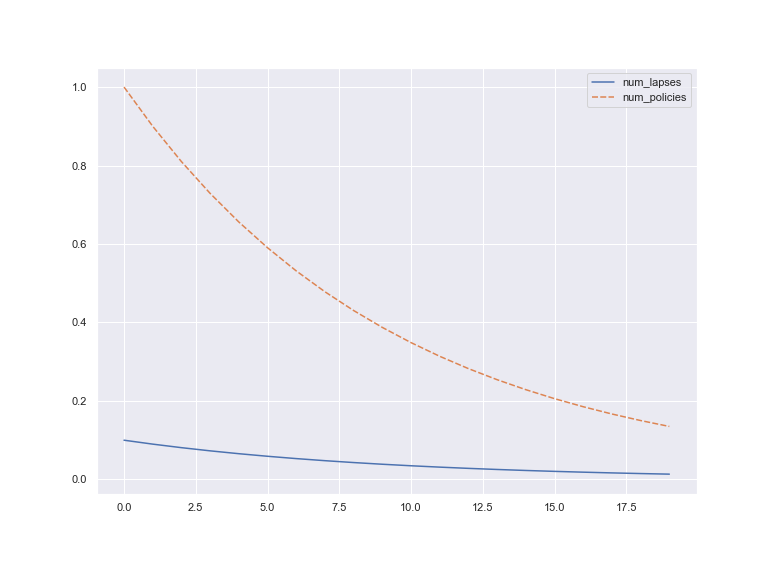Model Walkthrough
This section breaks down the individual segments of code within the example model outlined in the index.
The overall model is:
import pandas as pd
import seaborn as sns
sns.set()
from heavymodel import Model
class PersistencyModel(Model):
def num_policies(self, t):
if t == 0:
return 1
else:
return self.num_policies(t-1) - self.num_lapses(t-1)
def num_lapses(self, t):
return 0.1 * self.num_policies(t)
model = PersistencyModel()
model._run(20)
df = pd.DataFrame({"num_lapses":model.num_lapses.values, "num_policies":model.num_policies.values})
sns.lineplot(data=df)
Import libraries
We first import required libraries.
import pandas as pd
import seaborn as sns
sns.set()
from heavymodel import Model
pandas and seaborn are popular data and plotting libraries, for displaying the results. from heavymodel import Model makes the core Model class available.
Define the class
The user model is defined as a class, as follows:
class PersistencyModel(Model):
def num_policies(self, t):
if t == 0:
return 1
else:
return self.num_policies(t-1) - self.num_lapses(t-1)
def num_lapses(self, t):
return 0.1 * self.num_policies(t)
To make use of the functionality of heavymodel.Model, the user model inherits from this, as a sub-class.
Functions (num_policies, num_lapses) are defined as methods in the class. Each of these returns a result depending on the value of t.
Python methods take self as the first parameter, this refers to the instance of the class, when called, the self parameter is omitted, such as self.num_policies(t-1). If a data item (attribute) such as age was added, the value of it could be accessed through self.age.
For more information on python classes, see docs.python.org/3/tutorial/classes.html or other reputable tutorials.
Run the model
model = PersistencyModel()
model._run(20)
model = PersistencyModel() creates an instance of the model, with all the methods bound to it. For example, model.num_policies(50) would evaluate num_policies at t=50 (and all dependencies) and return the result. This allows models to be evaluated using the interactive prompt / REPL.
model._run(20) evaluates all the functions in the model from t=0 to t=19 (i.e. 20 time periods). Results are stored in model.<method_name>.values, e.g. model.num_lapses.values.
Extract and plot results
df = pd.DataFrame({"num_lapses":model.num_lapses.values, "num_policies":model.num_policies.values})
sns.lineplot(data=df)
This converts the results into a pandas dataframe, with column headers num_lapses and num_policies, and plots the result:
